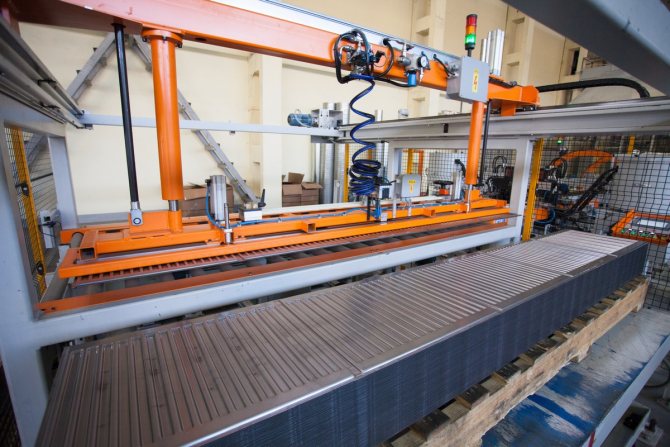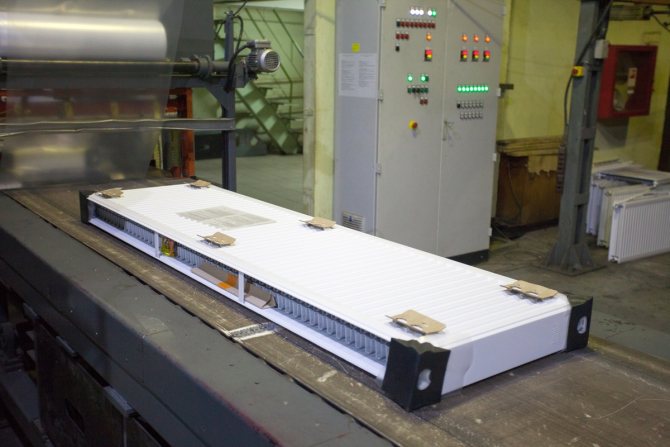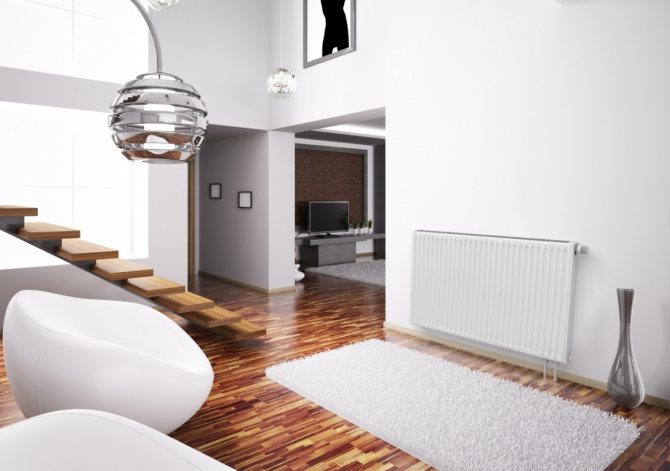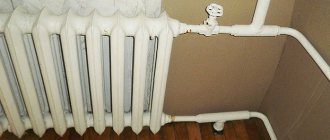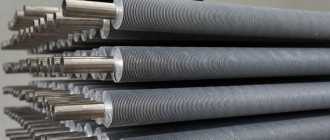Today, consumers have become more interested in Russian-made bimetallic radiators, since they are practically not inferior to foreign brands in many performance indicators. Domestic equipment is less demanding on the quality of the heat carrier for urban heating networks, but the design and build quality are highly commendable.

Bimetallic radiators - modern models of heating equipment
What domestic brands offer bimetal
Modernization of old heating systems is caused by necessity, and when creating new communications, the cost of components is of great importance. The latest climate systems offer savings in different ways:
- maximum insulation of houses and apartments;
- connection of Russian-made heating radiators from a budgetary and economical niche;
- inclusion of environmental technologies;
- heating system equipment with climate control, "smart home" and "warm floor" circuits, controlled from a smartphone or a presence sensor.
In houses of the old layout, not all modern methods are applicable, but every owner has access to the replacement of old cast-iron "accordions", which have a minimum efficiency due to clogging, with new heating sections made of bimetal.
The following Russian brands have firmly established themselves in the domestic market of heating equipment in the last 2-3 years:
- PRADO (Prado);
- Teplopribor;
- Royal Thermo;
- RIFAR (Rifar);
- KZTO;
- Itermic (Aitermik);
- Halsen;
- Thermal;
- Logatrend Buderus and others.


Bimetallic radiators are produced by many Russian enterprises
Russian batteries, such as the Royal Thermo revolution bimetall 350 (based on a steel tube), are in no way inferior in quality and reliability to Italian and German equipment. These products do not require expensive customs clearance and complex taxes, so their price is available to every buyer.
Only one domestic enterprise Royal Thermo produces up to 12 million sections per year, and there is a growth trend. Russian manufacturers also offer reliable pipes and fittings for them - not only made of steel, but also polymer ones. Experts believe that over time, our enterprises will meet all the needs of consumers from the Russian Federation and neighboring countries.
JSC NITI Progress was established in 1959. Over the past 50 years, the Institute has become one of the leading technological organizations of the Russian industry. The Institute has mastered unique technological processes of electron-beam and argon-arc welding of complex-alloyed steels and alloys, local heat treatment, production of high-strength pipes by rotary forging, tire balancing, abrasive-rotary processing, production of thin-walled shells by rotary drawing, manufacture of steel radiators and others. The history of the production of radiators begins in 2005, at the time when the President of the Udmurt Republic A.A. Volkov and General Director of OJSC NITI Progress A.V. Zorin cut the symbolic tape to the welding shop of the new production. From that moment on, the plant launched the production of panel radiators for water heating PRADO. In a short time, the radiator plant has grown into a modern, high-tech enterprise, which is not inferior in terms of technological training, technical equipment and qualifications of specialists to the world's leading manufacturers of steel panel radiators. The use of modern pressing equipment in combination with the sequential stamping technology made it possible to automate the stamping processes of almost all radiator parts as much as possible. Steel radiators "PRADO" are made from the highest quality materials and components and are continuously monitored during the production process.The team of the radiator is in constant search of new solutions to improve the quality of manufactured products, increase their operational characteristics, and optimize production processes.
|
|
|
|
| Stamping half panels | Loading half panels on the line | Rolling (installation) of liners | Rotation of every second half-panel (module) by 180 |
|
|
|
|
| Multi-point contact welding of panels (module) of a radiator | Tacking the convection sheet to the radiator panel | Resistance multi-spot welding of convection sheet to panel | Welding longitudinal seams of panels |
|
|
|
|
| Welding longitudinal seams of panels | Welding of transverse seams of panels | Welding of transverse seams of panels | Splitting a panel module |
|
|
|
|
| Cutting off sharp corners of panels | Finished panel corner | Positioning panels relative to each other | Welding of pipes and fittings |
|
|
|
|
| Welding of pipes and fittings | Embossed welding of brackets for fastening to a radiator | Testing radiators for strength and tightness | Testing radiators for strength and tightness |
|
|
|
|
| Hanging radiators on a conveyor line | Moving radiators to the surface preparation unit | Radiator priming | Powder coating |
|
|
|
|
| Moving painted radiators | Shrink wrapping of radiators | Shrink wrapping of radiators | Packing radiators on a pallet |
Variety of heating equipment from a Russian manufacturer
The reliability of the equipment is not an idle question on the territory of the country, where it is cold for more than six months, the heating season lasts almost as long. For a long time, they focused on cast iron batteries, then they were replaced by lighter bimetallic models of imported production. Almost simultaneously, proposals for other materials, including aluminum and copper, emerged.
With the advent of heating equipment with similar products on the market, Russian manufacturers had to expand their range of products, mastering the production of bimetallic radiators and aluminum or "semi-metal" radiators, such as Тhermo rus 500 80 (12 sections). All models are classified by material type:
- steel (base) and aluminum (outer shell);
- copper and aluminum.


Radiators are made from different types of metal
Domestic production of modern heating equipment is developing, in catalogs and specialized stores you can see all types of heating equipment:
- outdoor;
- wall;
- intra-floor.
According to the type of construction in Russia, solid (tubular) ones are produced, such as Monolit 350 100, and sectional models that can be extended in length. The most popular are STOUT Space 350 with 12 sections.
No less popular are the sectional models RBS 500 (bimetallic radiator BM from SANTEKHPROM JSC) and their domestic competitors - GLOBAL batteries. Products made of a steel or copper tube in an aluminum casing are distinguished by excellent thermal efficiency, they are more aesthetically pleasing and more practical than obsolete cast-iron counterparts, which had no alternative half a century ago.
However, design options that imitate old cast-iron "accordions" are also produced by Russian enterprises. Most often, these are floor-standing retro radiators with legs from Global, which are in no way inferior to imported samples - the design with soldering is impressive. They can be repainted, unlike some foreign cast iron batteries.
It is also pleasant to note that you can find well completing parts in the catalogs:
- vertical and horizontal models;
- floor convectors and built-in units;
- towel warmers and design radiators, made in the same way.


Bimetal radiators are connected in different ways
It is also easy to find more expensive models on sale, such as Ventil 200 and Base 500 - 100, with different types of connection to the system.There are side, diagonal and bottom (saddle) connections to central (and autonomous) heating pipes.
Types of cast iron radiators
At the moment, there are several types of batteries that differ not only in technical characteristics, but also in functional features. Consider the differences between species.
Single channel
We are talking about the structure of the sections - the number of channels. Such models are now not so common - as a rule, these are tall devices installed in the vertical plane. Each section of the radiator is equipped with a channel necessary for the circulation of the heat transfer fluid. The peculiarity of such batteries is that they are very easy to wash, so they are often installed in medical institutions.
Two-channel
For each section of such a heating device, 2 channels are allocated, as a result of which heat transfer increases. Additional ribbing, which is not found in single-channel models, also allows you to increase this indicator. Due to its compact size and optimal heat transfer, this type is now the most popular.
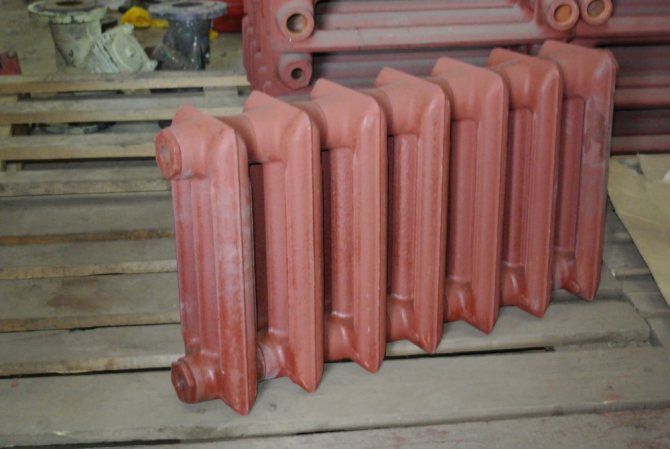

Three-channel
They differ in the highest rates of heat transfer in comparison with other heating devices. At the same time, due to the design features, such batteries are heavier and have a greater depth.
The width of the equipment increases from the number of sections and, accordingly, channels, so such devices are less common.


Wall mounted
There is one important condition here - the wall to which the battery will be attached must withstand its weight, so you need to calculate the required number of brackets. Models are also available that can be installed on the floor, depending on your wishes.
Recently, a special material has been used for the production of wall models - gray cast iron, the weight of which is several times less compared to the classic version.


Floor standing
These products are relevant for houses with a large panoramic window and a low window sill. Often, floor-standing batteries are chosen if the load-bearing wall simply cannot withstand the load of the traditional model.
Equipment with such an installation is popular for another reason: a large assortment of designer models, which, due to their attractive appearance, suit the interior features. The design can be minimalist, modern, palace and so on, so that each buyer can choose the right model.


Features of bimetallic products of domestic production
The quality of domestic products is due to the introduction of publicly available technologies, patented know-how from world brands and developments of domestic specialists of bimetallic heating radiators. One of the advantages is the protection of the inner surface, as in Rifar base ventil 350 type products.
The need for such an improvement in equipment is associated with the low quality of the coolant supplied to the central city systems.
Useful advice! While Russian standards for water circulating through central heating pipes are far from European standards, it is better to rely on domestic heating units.
Russian bimetallic products are different:
- high strength;
- adaptability to blowing and cleaning from rust and dirt;
- the ability to connect in different ways;
- adaptation of the battery format to the window-sill niche of most panel houses;
- the possibility of using antifreeze (non-freezing coolant in a closed circuit of private houses).


Such radiators are suitable for installation in residential, office and any other premises.
The characteristics give the right to assert that domestic products are no worse than imported counterparts, and remain more attractive in terms of cost.
Features of European-made radiators
First, let's clarify some technical details. In the modern version, the device can be:
- aluminum, steel, bimetallic, cast iron;
- multi-section, all-metal;
- with different configurations of heat-emitting elements - tubes, panels and finned surfaces;
- with convection or radiating function, and in many cases also hybrid due to a complex combination of elements.
Western manufacturers pay special attention to external design, which is why many models of radiators with beautiful surfaces and complete elegant shapes have appeared on the market. Such devices fit perfectly into any interior.
But the problem begins where leading European developers claim to “fully adapt” the product to the realities of the Russian market. What does the consumer face?
- Italian and German radiators are designed for operation in a heating system with lower operating pressure, a different temperature regime - the climatic difference. Therefore, for all their beauty, Western heating radiators do not differ in reliability and durability when used in Russian conditions.
- The active use of bimetallic structures, on the one hand, increases the service life of products, but at the same time significantly affects the cost of the radiator.
- Most European devices are pre-oriented to the consumer who will use a purified, well-prepared coolant.
If we are looking for products that can be used to equip a house or apartment with a view to long-term trouble-free use, then it makes sense to take a closer look at domestic developments.
What is the difference between heating made of steel and aluminum of Russian production
Bimetallic radiators from a Russian manufacturer demonstrate high reliability in extreme conditions - with water hammer in the system (pressure surges) and water pollution. The inner coating of the steel base protects the heating equipment well from rust.
Important! Although the manufacturer's documents indicate "stainless steel", over time, the internal protection loses its resistance to corrosive processes. They are inevitable, especially after draining the water from the pipes in the summer.
In Russian realities, the most attractive bimetallic radiators from foreign brands are often disappointing because of their inability to cope with extreme conditions. In addition, our products have a sufficient thickness of pipes and bodies, so heating systems are well tolerated during periods of severe frost.
Russian manufacturing plants have long ago moved away from the old production system and switched to new technologies that guarantee up to 20-30 years of flawless operation. They are encouraged not only by their functionality, but also by their excellent design - they perfectly fit into various interiors (houses, offices, shops).


Radiators of Russian manufacturers can be operated for several decades.
Russian batteries are manufactured from a steel frame in an aluminum casing, on which thermo enamel is applied. It is highly resistant to scratches and mechanical damage. If desired, the batteries can be repainted in a different color or reopened to eliminate defects, but the same (high temperature-resistant) paint for metal is needed.
Experts also recommend paying attention to domestic models from RIFAR and MONOLIT. They are several times cheaper than the Italian STYLE PLUS 500 and German TENRAD 500. Russian equipment remains optimal for heating all types of premises, including city apartments and the private sector, trading floors and office centers.
On the market you can find low-quality Chinese fakes of branded products:
- pipes and fittings for mounting batteries;
- bimetallic (and other) models;
- heating radiators;
- heated towel rails,
- convectors;
- design radiators.
Therefore, it is necessary to purchase heating equipment in company stores and retail outlets offering certified products.
Features of cast iron batteries
To understand what these heating devices are, you need to understand their design and study the characteristics. You should be aware that there are several types of cast iron products that are relevant in certain situations.
Specifications
The key indicators of all heating devices are the level of heat transfer and power. The efficiency of the device and the area that it can heat depend on them. As a rule, manufacturers indicate the power of one section of radiators, therefore, to calculate the required number of sections, the type and size of the room are taken into account.
As for the level of heat transfer, it all depends on the material of the battery. In this regard, cast iron is slightly worse compared to steel and aluminum. The level of thermal conductivity of cast iron is almost 2 times lower than that of aluminum. But low inertia compensates for this. That is, the battery heats up for a long time and also cools down for a long time.
For this reason, for a closed system with forced circulation, it is better to choose aluminum batteries, in which the coolant moves intensively. For an open system or if the circulation is natural, cast iron should be preferred.
One battery section has an average output of 160 watts. In comparison, the same indicator for aluminum or bimetallic products is 200 watts.
The heat dissipation of cast iron radiators is one issue. As a rule, difficulties arise when the buyer finds out the dimensions and weight of the product (more often the old model).
Let's consider the characteristics using the example of a domestic battery - MS-140:
- height - 59 cm;
- depth - 14 cm;
- the width of one section is 9.3 cm;
- weight - 7 kg;
- section capacity - 1.4 l;
- power (1 section) - 160 W.
For example, if 10 sections are required to heat a room, then the final mass of the device will reach 70 kg - of course, there is little pleasure during installation, but this procedure is done once.
If we consider the sensitivity to the coolant and the service life, cast iron products outperform all existing competitors. This is explained by the properties of the material itself - it is not afraid of abrasive wear, and it will not enter into chemical reactions with other materials. Each section has an impressive channel size, in which there is practically no clogging, so cleaning technical work is not needed so often.
According to manufacturers, modern cast-iron heating devices can last from 30 to 40 years. Nowadays, old-style batteries are still successfully used in many apartments.


Benefits
Cast iron radiators of the euro and the old type have similar advantages, which is due to the properties of the material itself - cast iron.
So, the positive properties of cast iron models are as follows.
- High resistance to corrosion ... One interesting property is noteworthy here: during operation, the so-called dry rust forms on the surface of the cast iron - further corrosion simply does not occur. And even if the coolant has a pH of more than 9.5, with pebbles, rust particles - this does not particularly damage the inner surfaces of the batteries.
- Thick walls ... This extends the life of the device. In addition, the devices are ideal for open systems with high oxygen content. Often, cast iron devices are installed in multi-storey buildings, where the system is drained in the summer. For example, radiators made from thin-walled, low-carbon steel will not work - they will rust after 2-3 seasons. Due to their high anti-corrosion resistance, cast iron products are optimal for steam heating systems, where the steam temperature reaches +150 degrees Celsius.
- Good heat storage capacity and high thermal inertia ... If you turn off the batteries, then after an hour they will give off 30% of the original heat. Steel - only 15%.
- Large internal section ... This means that the items need to be cleaned less frequently.
- Long service life ... If a high-quality coolant is used, then the heating device can last a whole century.
Despite the long list of advantages, cast iron batteries also have disadvantages.


disadvantages
There are not many disadvantages to cast iron products, but you need to consider them before making a purchase.
Disadvantages of heating systems assembled from cast iron:
- Heavy weight ... Depending on the number of sections, radiators can weigh up to 70 kg, so 2 or more people will be needed to deliver and install them. In addition, the wall must support the weight of the water system itself. If the walls are not strong enough, many manufacturers complete the batteries with special feet, with the help of which floor mounting is carried out.
- The inability to quickly warm up the room ... Difficulties also arise when regulating the temperature regime. It is explained by the type of heating - for cast iron products, this is the radial method.
- Requires a lot of water ... To fill one section of the battery, you need about 1 liter of water. For aluminum, 0.4 liters are required.
Despite the shortcomings, cast iron products continue to be in demand due to their simple and reliable design.


Advantages and disadvantages of domestic bimetal radiators
Bimetal has increased heat transfer. The only weak point of bimetallic models is the joints of steel and aluminum, where they join the pipes of the central heating.


Sectional models are good because they can be extended to the required length.
Emergency situations happen extremely rarely, but with a high probability of strong water hammer, it is better to take solid models, not sectional ones. It is better to entrust the installation of new heat blocks to specialists.
With proper connection, Russian batteries made of 2 types of metal are practically devoid of disadvantages:
- are distinguished by high strength, reliability and durability;
- have maximum efficiency;
- practically eliminates the likelihood of leaks in the body, even with an increase in the number of sections;
- are not inferior in design to the best imported brands, rounded ribs guarantee safety even in children's rooms);
- they are designed for high working pressure (up to 20 Atm);
- steel ducts are equipped with enhanced anti-corrosion protection;
- adapted for heat transfer fluids of any quality;
- products of different colors are presented in the catalogs, if you wish, you can contact the manufacturer and order a series of the required shade of heat-resistant enamel for your interior;
- many models are equipped with a thermostat and a flow control system to reduce the temperature of the batteries during warming (if it is absent, it is possible to install it at the junction with the pipes);
- radiators are presented in a large assortment in terms of overall format (length, width and depth) and the number of sections (different from the standard in 12 segments);
- high compatibility with pipes of any heating system, thanks to a wide range of couplings, fittings and adapters;
- the price tags for domestic models are much lower than those of imported bimetallic counterparts.
Like any product, bimetal radiators have certain drawbacks, which are important to know about before making a purchase.
- The batteries have small pipe diameters with a similar opening width, where dirt accumulates over time (cause clogging and reduced system efficiency). The problem is solved by cleaning the radiators. Prevention - filter installation.
- With a low-quality coolant, the service life is reduced.
- The differing coefficients of expansion of steel and aluminum when heated up quickly cause a characteristic crackle at the joints, but this can take some getting used to.
- The cost of steel and aluminum radiators is higher than cast iron, but this is not a reason to refuse to buy.


Dirt can accumulate over time in the joints of pipes and batteries.
Cast iron radiators from 900 rubles.
Russian production of cast iron radiators using imported equipment. Buy in Moscow and other cities.
CALCULATION OF THERMAL POWER OF HEATING RADIATORS BY SQUARE METERS
Heat sink power is the heat energy of the heat sink, measured in Watts (W).
So, there is a direct relationship between the heat loss of the room and the power of the radiator, i.e. if the room has a heat loss of 2400 W, then the radiator must be selected with the same power of 2400 W. But the temperature of the radiator can be in the range from 40-90 ° C and, accordingly, the power of the radiator will be different at different temperatures.


But, unfortunately, many do not understand how to find out the heat loss of a building ... There are simple calculations to determine the heat loss of a room. It will be written about them later.
And at what temperature will the radiator warm up?
If we have a private house with plastic pipes, then the temperature of the radiators will range from 45-85 degrees. The average temperature is 70 degrees. The maximum temperature is 85 degrees.
If you take an apartment with central heating, then from 40-95 degrees. The maximum temperature is 95 degrees. At the moment the central heating temperature is weather dependent. This means that the temperature of the central heating coolant depends on the temperature outside. When it gets colder outside, the temperature of the coolant is higher and vice versa. Therefore, the power of the radiators according to SNiP is calculated at ∆70 degrees. But this does not mean that you need to select this way. Management companies and similar organizations lay down the capacity so as to heat your apartment less and save money on heat energy, and take money from the rent as usual. To date, changing a radiator to a more powerful one is not prohibited. But if your radiator takes away heat strongly and there are complaints about the system, then measures will be taken against you.
Suppose that you have decided on the temperature of the coolant and the power of the radiator
Given:
Average heatsink temperature 60 degrees
Radiator power 1500 W
Room temperature 20 degrees.
Decision
When you search, ask for a 1500 W radiator, you will be offered a 1500 W radiator with a temperature difference of ∆70 ° C. Or ∆50, ∆30 ...
What is the temperature head of a radiator?
Temperature head is the temperature difference between the temperature of the radiator (heat carrier) and the temperature of the room (air)
The radiator temperature is conventionally the average temperature of the coolant. I.e
Let us assume that there is a series of radiators of certain capacities with a temperature difference of ∆70 ° C.
Model 1, 1500 W
Model 2, 2000 W
Model 3, 2500 W
Model 4, 3000 W
Model 5, 3500 W
It is necessary to select a radiator model with an average coolant temperature of 60 degrees.
In this case, the temperature head will be 60-20 = 40 degrees.
There is a formula for recalculating the power of radiators:
Uph - actual temperature head
Uн - standard temperature head
More about the formula: Calculation of the power of radiators. Standards EN 442 and DIN 4704
Decision


Answer: Model 5, 3500 W
Radiators Trend1 and Trend2
How do you like the modern design, but with a retro filling? Trends differ from other radiators in that they are not made in retro style, but in the style of modern radiators such as aluminum and bimetal. However, these radiators still have a retro style and it lies in the fact that they are made of natural, real cast iron in the best traditions of retro style. These radiators are in great demand not only because of their low price, but also due to the fact that they already fit into modern repairs, into any style, by the way, including retro.Because, if you look closely, they have a rough structure between the sections and the combination with retro-style taps (valves) can give odds to many retro-style radiators. These radiators are only suspended, the connection to them is through or lateral. 1 inch nipples. Dimensions Trend1: center distance: 500mm, height: 585mm, depth: 90mm, width: 60mm, section weight: 5.1kg. Dimensions Trend2: center distance: 500mm, height: 580mm, depth: 80mm, width: 60mm, section weight: 4.9kg.
On our website RETROROSSIYA.RF you can buy a retro radiator Trend1 and Trend2, and you can also choose any of our products, or call: 8-800-700-70-71. We are always glad to see you!
# cast iron radiators # antique radiators # cast iron # retro radiators # retro batteries # retro heating # cast iron heat # radiators # batteries # heat # retro interior # loft # vintage # retro Russia # retrobedeva @ retrolebedevа
Today we are talking about plugs for cast iron radiators.
Choose our product on the RETROROSIYA.RF website or call: 8-800-700-70-71.
We are always glad to see you!
#retrostyle # cast iron radiator # cast iron #retrobedev #retrorussia @retrolebedev #retrorepair #retrodom
Russian, domestic heating batteries
Installation of rifar radiators is in demand today. And this is not surprising. After all, this company has existed for more than ten years in our country. The main activity of this manufacturer can be called Russian heating batteries made of aluminum or a combination of two materials - steel and aluminum. The latter combination allows the creation of so-called bimetallic heating units.


Why do many people choose rifar:
- design and production are carried out taking into account the quality of heat transfer fluids in systems
- Also, the designers do not lose sight of the fact that hydraulic shocks very often occur in our heating communications
- all possible situations that can damage radiators and the system as a whole are taken into account


Rifar produces domestic batteries and relatively cheap radiators with optimal performance. Russian-made batteries from the manufacturer Rifar have external protection against mechanical damage - in the form of a special coating. Internal protection allows you not to worry about the fact that the batteries will soon become covered with rust.
Features of the choice and advantages of steel tubular radiators KZTO (KZTO)
If we talk about what brand of heating radiator to choose from among Russian brands, we recommend that you study the main parameters of the products and take into account important features:
- Heavy cast iron products keep the temperature well, but require increased reliability of fastening and protection from impacts.
- Bimetallic batteries, as a rule, are much more expensive than aluminum ones, have an increased service life and good heat transfer due to the use of an aluminum case. But they have a branched surface, from which it is difficult to remove dirt.
- Products with a copper insert are well protected from destruction when using antifreeze in the heating system - this makes it possible to limit its use in winter and not risk the failure of radiators due to freezing.
- Russian developments in the field of steel radiator design are a number of interesting solutions that are worth mentioning separately.
The design of steel radiators KZTO (KZTO) is an example of the competent use of modern technologies and combinations of a radiator with a convector. The “Harmony” line of radiators are devices in which the coolant enters and moves along the inner cavity of a double-walled tube. Due to the heating of the outer and inner surfaces, a convection effect arises, which increases the efficiency of heating the room.
The design of the tubular battery turned out to be almost universal - it can be built into a classic, modern, high-tech style room. At the same time, the entire surface is accessible to remove dust and other contaminants.
We recommend opting for domestic models of radiators, in particular those produced by KZTO, if you are looking for products that combine reliability, stylish design and a favorable price.
Overview of Russian-made heating boilers


Boiler in the heating system
Boilers are the main component of any water heating system. They are designed to heat the coolant to the desired level. Then hot water flows through pipes to radiators and batteries, with the help of which the premises are heated.
Currently, Russian-made solid fuel heating boilers and their gas counterparts are popular. To choose a particular model, you must adhere to the following rules:
- Optimal power calculation... In the process, the heat losses of the building, the climate and the required level of heating of the room are taken into account;
- Type of fuel... For houses with a large area, gas floor heating boilers made in Russia are well suited;
- Planned budget... This is the main advantage of the products of domestic brands. Most of the models have an ideal price / quality ratio.
To complete the heat supply, you can use Russian-made solid fuel heating boilers or gas models. For a detailed analysis, it is necessary to consider the main domestic "players".
Before purchasing Russian-made aluminum heating radiators or any other products, you must familiarize yourself with the quality certificate or a document confirming the state inspection of the goods.
Gas heating boilers


Gas boilers Conord
Heating components using gas as an energy carrier can be divided into two conventional types - floor and wall. Gas floor heating boilers made in Russia have proven themselves well in organizing heat supply for large residential buildings and industrial premises. Their power can reach 500 kW.
An important point when choosing Russian-made gas heating boilers is their reliability and compliance of the actual technical characteristics with the normative ones. Based on these requirements, several manufacturers can be distinguished whose products meet international standards:
- Conord... Their products belong to the economy segment of the heating technology market. But despite this, the boilers have reliable control and safety automation. The efficiency is about 90%. It is noticed that after several years of operation the turbulator breaks down;
- Signal... The company offers boilers with a minimum output of 6.5 to 40 kW. The heat exchanger is made of steel, which requires periodic flushing. The design of the boiler is designed to take up the minimum space in the room. Disadvantage - increased gas consumption at maximum load;
- Borinsky... The company's products are characterized by the largest assortment. Also worth noting is the good quality of the burners made of stainless steel. The customer is given the choice of a complete set with domestic control devices or their foreign counterparts. A feature of the operation of these gas floor heating boilers made in Russia is the increased requirements for the quality of fuel, susceptibility to corrosion of the body.


Wall mounted boiler Neva Lux
The average cost of equipment is from 10 to 55 thousand rubles. As well as Russian-made heating batteries, gas boilers must have a guarantee.
Wall-mounted models of gas heating boilers manufactured by Russian companies also have a large assortment. Among them are the following trademarks:
- Neva... Almost all boilers of the company have a stainless steel heat exchanger. This significantly increases their service life. For the assembly, ready-made models of foreign manufacturers are used. It is important to choose the right model - some of them are not intended for heating residential premises - Russian-made bimetallic heating radiators in such a system can quickly fail;
- GazLux... The advantage of using these boilers is the normal operation of the system even at low gas pressure. As well as the Neva models, they have two circuits - one for heating, and the other for hot water supply.
What is better to choose - gas floor heating boilers made in Russia or their wall-mounted counterparts? If the heated room is small, it is recommended to opt for wall-mounted models.
When choosing a boiler model, it is necessary to pay attention to the type of burner - open or closed. Almost all floor structures have an open view of a gas burner.
Solid fuel boilers for heat supply


Solid fuel boiler Siberia
Historically, the number of companies specializing in the production of Russian-made solid fuel heating boilers is much larger than gas ones.
The constant growth of requirements for product quality and competition stimulated the development of this segment of heating equipment. Over the past two decades, several new companies have appeared, whose products can safely compete with foreign counterparts:
- Siberia... The production association produces the most popular type of solid fuel boilers equipped with a heat exchanger and a hob. They can be installed to heat a house or a small summer cottage;
- Hearth... Despite the relatively short term for the creation of this brand, the Ochag boilers have established themselves as reliable and modern components of the heating system. Together with them, you can install Russian-made heating radiators, as well as their foreign counterparts;
- Zota... They have one characteristic design feature - two fire doors. They can be used for vertical or horizontal loading of fuel. Convenient for use in small spaces.
The pricing policy of Russian companies for the production of solid fuel heating boilers is focused on the available market segment. But despite this, their products meet all international quality standards.
The thickness of heat-resistant steel in solid fuel boilers must be at least 2 mm.



